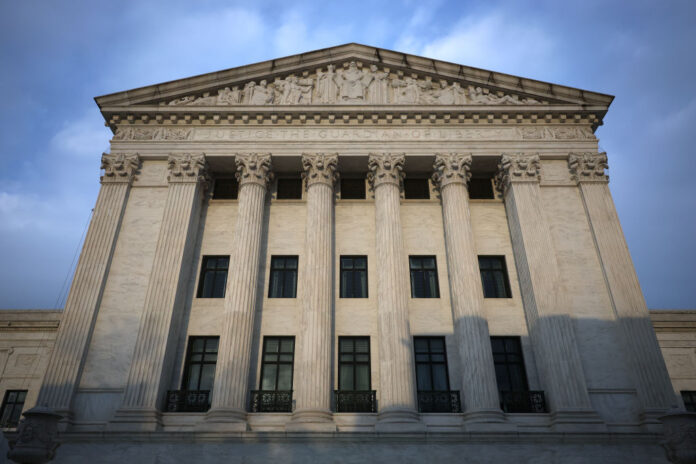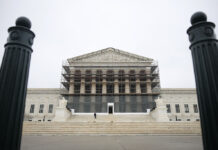Setting the stage for a major ruling on presidential power, the Supreme Court on Tuesday agreed to decide whether a 1977 federal law giving the president certain emergency powers allowed President Donald Trump to levy tariffs on nearly all goods imported into the United States through a series of executive orders.
In a brief order issued by the court’s Public Information Office on Tuesday afternoon, the court announced that it had granted review in two cases: Learning Resources v. Trump, in which two small businesses had asked the justices to weigh in on Trump’s power to impose the tariffs without waiting for a federal appeals court to rule on the Trump administration’s appeal; and Trump v. V.O.S. Selections, in which the Trump administration had asked the court to review a ruling by a different federal appeals court striking down the tariffs. The court will fast-track the two cases, which will be argued together, and hold oral arguments in early November.
In a series of executive orders, Trump imposed tariffs that fall into two categories, which collectively cover a wide range of products from U.S. trading partners. The first category, known as the “trafficking tariffs,†apply to goods from Canada, China, and Mexico, which in Trump’s view have not done enough to halt the flow of fentanyl into the United States. The second category, known as the “reciprocal tariffs,†impose a minimum tariff of 10% (which can escalate up to 50%) on products from virtually all countries.
The law at the center of the case is the International Emergency Economic Powers Act, a 1977 law that allows the president to take action to “deal with any unusual and extraordinary threat, which has its source in whole or substantial part outside the United States, to the national security, foreign policy, or economy of the United States†if he declares a national emergency “with respect to such threat.†When he imposed the tariffs, Trump relied on IEEPA, and in particular on a provision of the law that authorizes the president, in times of national emergencies, to “regulate . . . importation†of “property in which any foreign country or a national thereof has any interest.â€
Two small family-owned businesses, Learning Resources and hand2mind, challenged the tariffs in federal court in Washington, D.C. They contend that paying the tariffs in 2025 will cost them $100 million – nearly 45 times as much as they paid in 2024.
In a decision on May 29, U.S. District Judge Rudolph Contreras ruled that the IEEPA tariffs were illegal and barred the Trump administration from enforcing the tariffs against the two businesses.
In an unusual move, the challengers came to the Supreme Court in June, asking the justices to take up the case without waiting for the U.S. Court of Appeals for the District of Columbia Circuit to decide the Trump administration’s appeal. They urged the justices to act quickly, telling them that “paralyzing uncertainty†is created when tariffs are “added and subtracted at will.â€
The Trump administration urged the court to stay out of the dispute. It countered that the Learning Resources case did “not warrant the extraordinary step of granting†review before the D.C. Circuit had weighed in on the government’s appeal, particularly when the D.C. Circuit had “expedited its consideration of the appeal.†Moreover, it added, Contreras did not have the power to take up the challengers’ case.
The justices denied the request by Learning Resources and hand2mind to fast-track the consideration of their petition for review.
Meanwhile, in a pair of separate challenges to the tariffs, filed by another group of small businesses and a group of states, led by Oregon, the Court of International Trade on May 28 ruled that both categories of tariffs – the trafficking tariffs and the reciprocal tariffs – exceeded Trump’s power under IEEPA.
By a vote of 7-4, the U.S. Court of Appeals for the Federal Circuit, which hears appeals from the Court of International Trade, upheld that ruling in a lengthy opinion on Aug. 29. It explained that, among other things, when “Congress intends to delegate to the President the authority to impose tariffs, it does so explicitly, either by using unequivocal terms like tariff and duty, or via an overall structure which makes clear that Congress is referring to tariffs.â€
In a petition for review filed on Sept. 3, U.S. Solicitor General D. John Sauer – the Trump administration’s top lawyer before the Supreme Court – told the justices that the “tariffs and the ensuing trade negotiations with all our major trading partners are pulling America back from the precipice of disaster, restoring its respect and standing in the world, eliminating decades of unfair and asymmetric trade policies that have gutted our manufacturing capacity and military readiness, and inducing our trade partners to invest trillions of dollars in the American economy.â€
The small businesses agreed that the Supreme Court should review the Federal Circuit’s ruling, but they continued to insist that “the tariffs are unlawful for multiple reasons, the government’s arguments to the contrary are flawed, and invalidating these tariffs will not deprive the President of the ability to impose other tariffs and negotiate lawful trade agreements under the numerous statutes that Congress has enacted for that purpose.â€
Oregon and the other states echoed that sentiment in their brief, telling the justices that “although the Federal Circuit got it right—and although the petition is littered with inaccuracies, hyperbole, and citations to material outside the summary judgment record—the state respondents agree that this Court should grant expedited review.â€
On Tuesday afternoon, the Supreme Court did just that. It instructed the Trump administration to file its opening brief on Sept. 19, with the challengers’ briefs to follow on Oct. 20. “The cases will be set for argument in the first week of the November 2025 argument session,†which begins on Nov. 3.
Posted in Featured, Merits Cases





